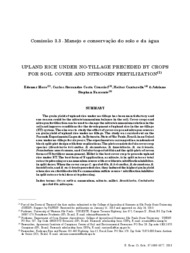Upland rice under no-tillage preceded by crops for soil cover and nitrogen fertilization.
Upland rice under no-tillage preceded by crops for soil cover and nitrogen fertilization.
Author(s): MORO, E.; CRUSCIOL, C. A. C.; CANTARELLA, H.; NASCENTE, A. S.
Summary: The grain yield of upland rice under no-tillage has been unsatisfactory and one reason could be the nitrate/ammonium balance in the soil. Cover crops and nitrogen fertilization can be used to change the nitrate/ammonium relation in the soil and improve conditions for the development of upland rice in the no-tillage (NT) system. The aim was to study the effect of cover crops and nitrogen sources on grain yield of upland rice under no tillage. The study was carried out on the Fazenda Experimental Lageado, in Botucatu, State of São Paulo, Brazil, in an Oxisol area under no-tillage for six years. The experiment was arranged in a randomized block split-plot design with four replications. The plots consisted of six cover crop species (Brachiaria brizantha, B. decumbens, B. humidicola, B. ruziziensis, Pennisetum americanum, and Crotalaria spectabilis) and the split-plots of seven forms of N fertilizer management. Millet is the best cover crop to precede upland rice under NT. The best form of N application, as nitrate, is in split rates or total rate at topdressing or an ammonium source with or without a nitrification inhibitor, in split doses. When the cover crops C. spectabilis, B. brizantha, B. decumbens, B. humidicola, and B. ruziziensis preceded rice, they induced the highest grain yield when rice was fertilized with N as ammonium sulfate source + nitrification inhibitor in split rates or total dose at topdressing.
Publication year: 2013
Types of publication: Journal article
Unit: Embrapa Rice & Beans
Observation
Some of Embrapa's publications are published as ePub files. To read them, use or download one of the following free software options to your computer or mobile device. Android: Google Play Books; IOS: iBooks; Windows and Linux: Calibre.
Access other publications
Access the Agricultural Research Database (BDPA) to consult Embrapa's full library collection and records.
Visit Embrapa Bookstore to purchase books and other publications sold by Embrapa.

